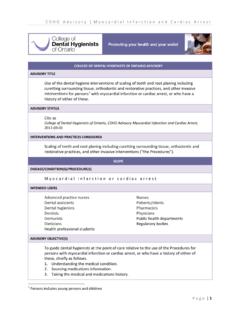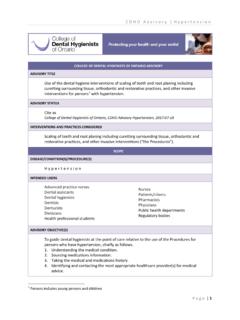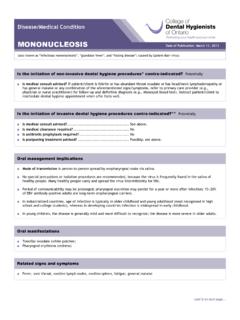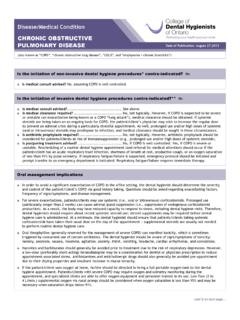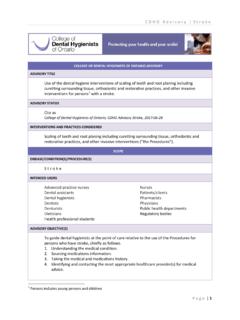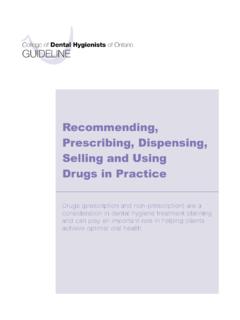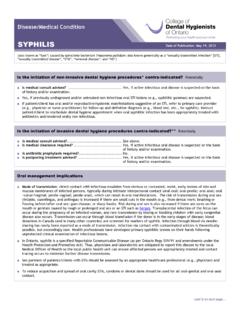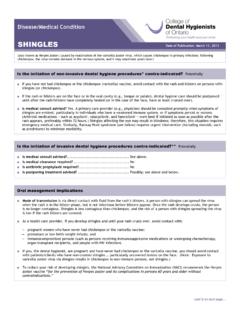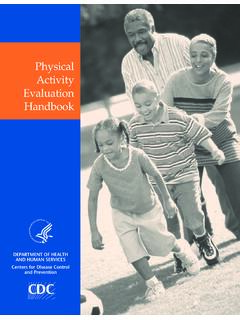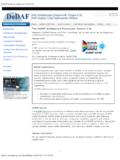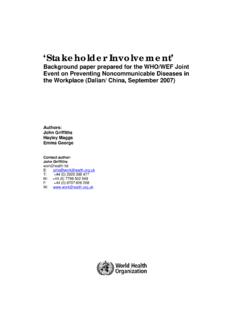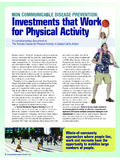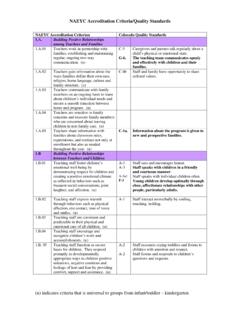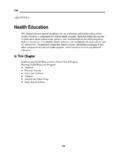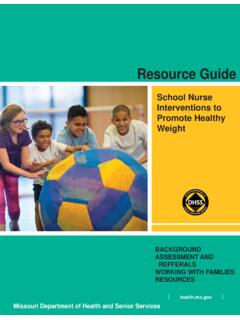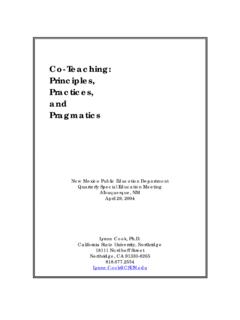Transcription of COLLEGE OF DENTAL HYGIENISTS OF ONTARIO …
1 CDHO Advisory | Joint Replacement Page | 1 1 Persons includes young persons and children COLLEGE OF DENTAL HYGIENISTS OF ONTARIO ADVISORY ADVISORY TITLE Use of the DENTAL hygiene interventions of scaling of teeth and root planing including curetting surrounding tissue, orthodontic and restorative practices, and other invasive interventions for persons1 with joint replacement. ADVISORY STATUS Cite as COLLEGE of DENTAL HYGIENISTS of ONTARIO , CDHO Advisory Joint Replacement, 2015-01-27 INTERVENTIONS AND PRACTICES CONSIDERED Scaling of teeth and root planing including curetting surrounding tissue, orthodontic and restorative practices, and other invasive interventions ( the Procedures ).
2 SCOPE DISEASE/CONDITION(S)/PROCEDURE(S) Joint replacement INTENDED USERS Advanced practice nurses DENTAL assistants DENTAL HYGIENISTS Dentists Denturists Dieticians Health professional students Nurses Patients/clients Pharmacists Physicians Public health departments Regulatory bodies ADVISORY OBJECTIVE(S) To guide DENTAL HYGIENISTS at the point of care relative to the use of the Procedures for persons who have joint replacement, chiefly as follows. 1. Understanding the medical condition. 2. Sourcing medications information. 3. Taking the medical and medications history. 4. Identifying and contacting the most appropriate healthcare provider(s) for medical advice. CDHO Advisory | Joint Replacement Page | 2 5.
3 Understanding and taking appropriate precautions prior to and during the Procedures proposed. 6. Deciding when and when not to proceed with the Procedures proposed. 7. Dealing with adverse events arising during the Procedures. 8. Keeping records. 9. Advising the patient/client. TARGET POPULATION Middle Age (45 to 64 years) Aged (65 to 79 years) Aged 80 and over Male Female Parents, guardians, and family caregivers of children, young persons and adults with joint replacement. MAJOR OUTCOMES CONSIDERED For persons who have joint replacement: to maximize health benefits and minimize adverse effects by promoting the performance of the Procedures at the right time with the appropriate precautions, and by discouraging the performance of the Procedures at the wrong time or in the absence of appropriate precautions.
4 RECOMMENDATIONS UNDERSTANDING THE MEDICAL CONDITION Terminology used in this Advisory Resources consulted Total Hip Replacement: American Academy of Orthopaedic Surgeons Total Hip Replacement: Cleveland Clinic Total Joint Replacement: American Academy of Orthopaedic Surgeons Total Knee Replacement: American Academy of Orthopaedic Surgeons 1. Arthroplasty, alternative term for joint replacement. 2. Bacteremia, the transient presence of bacteria in the blood that a. is the principal means by which local or superficial infections spread to the body s internal organs and structures b. often results from simple cuts or scratches c. may occur after oral healthcare procedures, minor surgery or other invasive procedures d.
5 Normally elicits a vigorous immune response to prevent the bacteria from spreading e. in the presence of an impaired immune system may be dangerous. 3. Hematogenous seeding of artificial joints when, in bacteremia, bacteria pass from the blood stream into artificial joints, which a. may CDHO Advisory | Joint Replacement Page | 3 i. occur as early infections ii. occur as late infections iii. be associated with acute infection in the oral cavity iv. arise during 1. normal daily life 2. DENTAL , urological and other surgical and medical procedures b. does not parallel infective endocarditis (CDHO Advisory) because, in the development of infective endocarditis the anatomy, blood supply, microorganisms and mechanisms of infection differ fundamentally.
6 4. Infection phases in joint replacement comprise a. early infections, which i. occur in the days or weeks following joint replacement ii. are generally easier to treat than late infections b. late infections, which i. occur months or years following joint replacement ii. almost always require 1. removal of the implant and subsequent revision surgery 2. intensive antibiotic treatment. 5. Joint replacement, total joint replacement, in which a biological joint is surgically replaced by an artificial joint. 6. Megaprostheses, which a. are used to reconstruct bones as well as joints affected by disease, such as cancer, or major injury b. are subject to infection, a common complication.
7 7. Prosthesis, in the context of orthopedics, is a device used to replace a. a diseased joint or bone b. a damaged joint or bone. 8. Revision surgery, chiefly a. replacement of an existing artificial joint with a new one because it is infected, worn out, loosened, or associated with bone fracture b. needed after expiry of the service life-time of an artificial joint, which i. ranges from ten to fifteen years ii. may be shortened by mechanical stress related to obesity or excessive physical activity. 9. Synovial joint, a type of joint that in most instances permits substantial movement, in which a. the articulating bones are separated by cavity containing synovial fluid b.
8 The ends of the bone are covered with articular cartilage. Overview of joint replacement Resources consulted Antibiotics for Prevention of Periprosthetic Joint Infection Following Dentistry: Time to Focus on Data Clinical Infectious Diseases | Antibiotics: Your Heart and Joints (Antibiotic Prophylaxis) | American DENTAL Association CDA Position on Antibiotic Prophylaxis for DENTAL Patients with Total Joint Replacement: Canadian DENTAL Association CDHO Advisory | Joint Replacement Page | 4 Comment on the 2009 American Academy of Orthopaedic Surgeons Information Statement on Antibiotic Prophylaxis for Bacteremia in Patients with Joint Replacements : The Arthritis Society Preventing Infection After Surgery.
9 The Arthritis Society Overview of interpretations of infection risk in joint replacement and the role of antibiotic prophylaxis See also Chronology The American Academy of Orthopaedic Surgeons and the American DENTAL Association Evidence-Based Guideline In December 2012, the American Academy of Orthopaedic Surgeons in conjunction with the American DENTAL Association conducted a systematic review and released a joint evidence-based clinical practice guideline. 1. The AAOS and ADA joint evidence-based clinical practice guideline at December 7, 2012, a. explains that a systematic review was conducted between October 2010 and July 2011 that demonstrated where there was good evidence, where evidence was lacking, and what topics future research should target to improve the prevention of orthopaedic implant infection in patients undergoing DENTAL procedures b.
10 Notes that a clinical practice guideline was created and based on a systematic review of published studies related to the prevention of orthopaedic implant infection in patients undergoing DENTAL procedures c. encourages readers to consider the information presented in the guidelines d. advises that i. the statement represents AAOS and the ADA s current recommendations on antibiotic prophylaxis ii. AAOS regularly reviews and updates all informational statements as new technology, evidence, or policy is developed iii. the guidelines are not intended to be a fixed protocol as some patients may require more or less treatment or different means of diagnosis and is not intended as the standard of care nor as a substitute for clinical judgment as it is impossible to make recommendations for all conceivable clinical situations in which bacteremias may occur iv.

